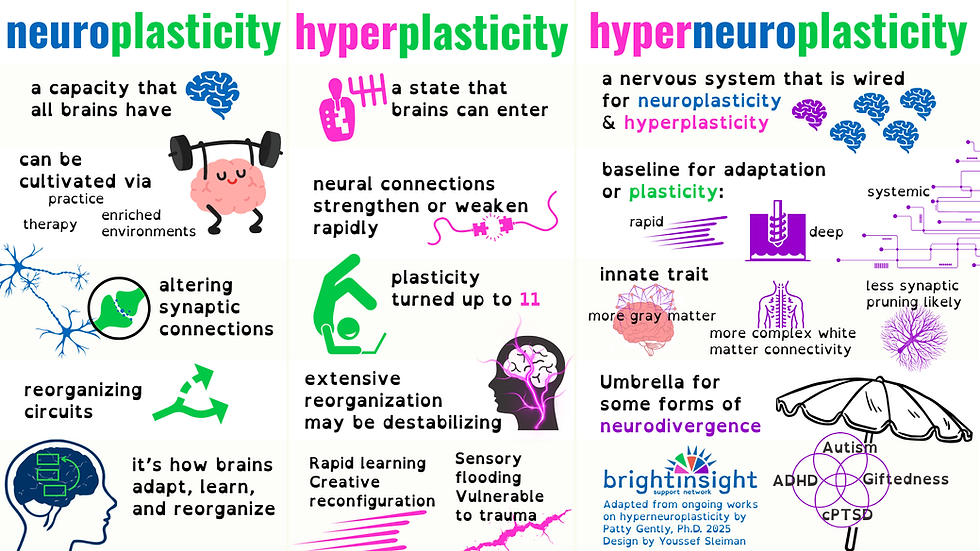Neuroplasticity and Hyperplasticity vs. Hyperneuroplasticity
- Dr. Patty Gently

- Sep 13
- 2 min read
Updated: Sep 15
By Dr. Patty Gently on September 13, 2025


Bright Insight Support Network founder and president Dr. Patricia Gently supports gifted and twice-exceptional adults in their own autopsychotherapy through identity exploration, structured reflection, and alignment with inner values. A writer, educator, and 2e adult, Dr. Patty centers depth, integrity, and complexity in all aspects of her work.
Enjoy this and other posts by @thegentleheretic on Substack!
Neuroplasticity and Hyperplasticity vs. Hyperneuroplasticity
Neuroplasticity refers to the brain’s universal ability to change by altering synaptic strength, reorganizing circuits, and adapting to experience. It is a capacity that can be cultivated through practice, therapy, or enriched environments, and while powerful, it operates within a relatively moderate range for most people. In this sense, neuroplasticity is the neurological process of adaptation.
Hyperplasticity, by contrast, is an intensified form of plasticity in which neural systems display heightened and sometimes destabilizing levels of adaptability. In hyperplastic states, neural connections may strengthen or weaken more rapidly, reorganize more extensively, or shift more fluidly than typical. Hyperplasticity is often described in research as plasticity “turned up too high,” bringing both opportunity (rapid learning, creative reconfiguration, resilience after injury) and risk (instability, sensory flooding, vulnerability to trauma).
Hyperneuroplasticity (HNP) captures what happens when a whole system is set up for both neuroplasticity and hyperplasticity. It is not simply stating that plasticity can be encouraged. Rather, it explains a system that operates from a baseline orientation toward rapid, deep, and systemic reconfiguration. In an HNP system, plasticity is not only more easily activated, it is also present in greater overall volume and density, manifesting in higher levels of gray matter and more complex white matter connectivity. This makes it a systemic, trait-like quality rather than a learned or encouraged one.

Because of this, HNP provides a useful umbrella for grouping certain forms of neurodivergence. Profiles such as autism, ADHD, giftedness, and trauma-shaped neurodivergence often share systemic hyperresponsiveness: accelerated learning, fluid identity shifts, sensory amplification, and greater susceptibility to both brilliance and destabilization. Seen through the lens of hyperneuroplasticity, these are all variations of a shared underlying orientation toward intensified plastic responsiveness.





Comments